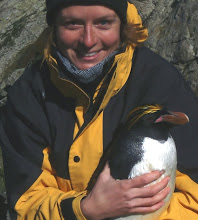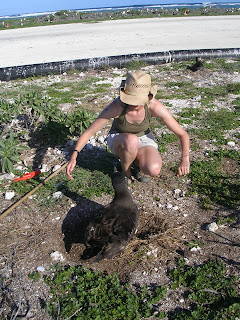Our main activity this week has been continuing with the albatross adult survival monitoring project. This involves reading the band number of every breeding albatross on the island, in a series of four 'sweeps', and catching and banding any unbanded individuals. Each albatross has two bands, one on each leg. There is a metal band with a unique 9-digit number and also a larger plastic (or auxilliary) band with a four character code. The plastic bands are easier to read from a distance, but are not as durable as the metal bands, so have to be replaced more often.
A Laysan albatross on its slightly more impressive nest.
As with all scientific endeavours the correct equipment is essential, and for albatross monitoring this consists of a long stick, with which one pokes the albatross until it stands up enough for you to read the auxilliary band number. Albatross are not particularly aggressive, but nevertheless they do not like being poked and will snap their bill at you to try and scare you off. Imagine an angry pair of scissors and you will have some idea what this is like. Most of the albatrosses on Tern Island are already banded, but from time to time we come across one that is missing one or both bands, and then a whole new game begins: catching the albatross.
How to catch an albatross:
1. Approach the albatross, trying to appear nonchalent.
2. Avoiding razor-sharp, snapping bill, gently push albatross's head forward.
3. With other hand, grab hold of razor-sharp bill.
4. Taking care not to release razor-sharp bill, slide free arm around albatross's body.
5. Lift & cuddle.
Ruth vs. albatross.
Albatross love to be cuddled.
Melinda and Sarah band an albatross.
Each albatross gets two bands, one metal and one plastic.
How to release an albatross:
1. Place albatross gently on ground.
2. Release and run away quickly.
Actually there is little danger of attack when releasing an incubating albatross, so overwhelmed are they by devotion to The Egg. Even after suffering the indignity of being grabbed, manhandled and banded, the released albatross will usually walk (or in many cases run) back over to its Egg. It then stands astride The Egg, looks down at it and honks concernedly as if to say "I'm back now! It's all OK!". You often see non-breeding adults performing this move too- standing looking at their own feet and honking ("I really wish I had an egg"). And they are not above thievery. Sometimes when we are banding an albatross, another albatross will walk by, notice the exposed egg, and come over and sit down on it. We then have to chase this albatross away before releasing the real owner of the egg.
Where's my egg? There it is!
The Egg. This one was abandoned- I didn't just whip it out from under an albatross.












No comments:
Post a Comment